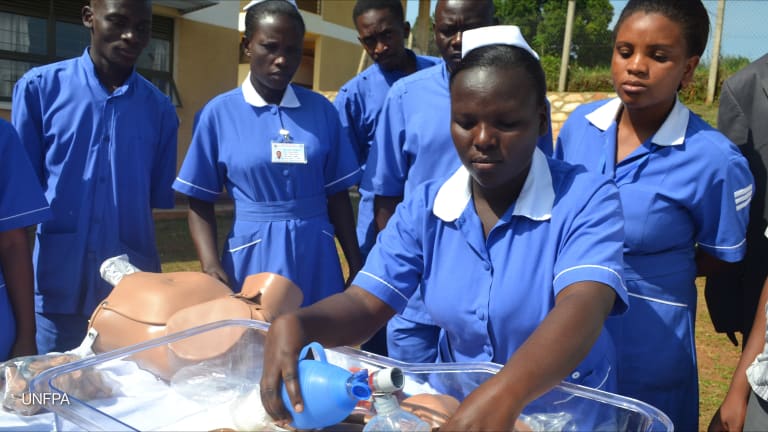
NEW DELHI, India — India’s 800,000 community health workers form the backbone of the country’s vast health care system; more often than not they are the first point of care in rural, remote and underserved areas. As in many countries, they play an invaluable role in reducing preventable deaths among mothers, children and infants.
Apart from its size, what sets India’s vast network of so-called Accredited Social Health Activists apart is how they are paid. ASHAs receive only outcome-based remuneration based on how many patients they serve and the specific targets they meet.
Incentivized pay can be a powerful tool, motivating workers to reach out to those in need and offering services aligning to national goals. Yet in some cases, advocates worry that the incentivized pay may be encouraging behavior that doesn’t put the patient’s interests first.
Specifically, India’s family planning policy provides ASHAs with targets, set by state and district offices, for sterilization, a form of permanent birth control. Women who use this form of family planning are paid up to Rs 1000 ($15) to undertake the operation while ASHA workers are remunerated Rs 150 ($3) for each woman they bring to the health care center or hospital. In some “high target” states women are paid even more to undergo the procedure.
Human rights groups say those incentives explain why sterilization makes up 86 percent of modern contraceptive use in India, with 4 million female sterilizations yearly. Many ASHAs don’t offer other choices for women seeking family planning, they argue.
“When the ASHA or health worker doesn’t give you a choice, what is it? It is coercion,” says Poonam Muttreja, executive director of the Population Foundation of India, a national nongovernmental organization that focuses on the formulation and implementation of gender sensitive health policies. “Quality should be the incentive, not money.”
Questions about remuneration — what type works best, when, how much, and why — matter more than ever as the public health community pushes toward the global goal of universal healthcare. Community health workers were singled out by the World Health Organization in its Workforce 2030 strategy as vital to achieving sustainable development goal targets linked to health.
“If we’re serious about achieving UHC and curbing preventable deaths among mothers, infants and children, no doubt sustainable investment in [community health workers] will be absolutely essential,” says Colin Gilmartin, technical officer specializing in health care financing at Management Sciences for Health. “More and more we are seeing financing for [community health workers] framed as investments, framed by their returns.”
Yet incentives must be calibrated carefully if they are to avoid unintended pressure on patients and health workers alike to always prefer one particular treatment or outcome, advocates warn.
A tarnished history
India turns to the private sector to bring health care to underserved areas
At a government hospital in the northern Indian state of Haryana, a public-private partnership is working to bring high-end diagnostic services to those who previously couldn't afford it, or lacked access. It's here where technology is enabling the state's best radiologists to connect with patients in far-flung areas.
India’s family planning program has focused on sterilization since the 1970s when the government, encouraged by loans from the World Bank and the United Nations Population Fund, embarked on a mass population control program. Initially the program focused on men; in 1975 when Prime Minister Indira Gandhi declared a state of emergency, more than 6 million men were sterilized. Poor rural men were targeted, with hundreds of thousands being coerced into the procedure, lured by the promise of money, among other incentives.
The goal at the time was to help control the country’s population. In the mid-1970s India’s total fertility rate was 5.2; today it is 2.3. But social and economic progress has been attributed to the decline in the country’s fertility rate, not sterilization.
Following the outcry over the mass sterilization of men, the focus shifted to women. That policy, too, has been marred by controversy. Women have been coerced into the procedure in unhygienic, unsafe conditions, which has resulted in dozens of deaths in rural areas.
Parallel to its population policy, in 2005 as part of the government’s National Health Mission, India introduced the role of an ASHA worker to act as an interface between the community and the public health system. The goal was to have an ASHA worker — whose tasks included encouraging women to have an institutional birth, promoting universal immunization, encouraging and mobilizing access to family planning, educating the community on nutrition and treating basic illnesses — present in every village across the country.
The Indian government said it was taking a “target-free” approach to family planning as early as 1996. But incentivized pay continued, and human rights groups say health workers felt pressured to encourage sterilization.
“Health workers who miss sterilization targets because they give proper counseling and accurate information about contraception risk losing their jobs in many parts of the country,” Aruna Kashyap, a lawyer and women’s rights researcher at Human Rights Watch wrote in a 2012 report.
In response to criticism about the focus on sterilization, India’s new national health policy outlines the government’s plan to increase the proportion of male sterilization, which is currently less than 5 percent, to 30 percent.
Last year, India’s top court also highlighted the ongoing controversy around coerced sterilization and ordered the government to close sterilization camps within three years, following the deaths of dozens of poor rural women. The camps, which were organized by state governments and local NGOs, regularly performed serial sterilizations on poor women without them fully understanding what the procedure meant, often in unhygienic settings.
The policy shifts offered advocates some hope that India would move away from its focus on female sterilization and provide more contraceptive options to women.
But recent research shows there’s a long way to go. According to the latest National Family Health Survey, just more than 4 percent of women using modern contraceptives rely on the contraceptive pill, 1.5 percent on intrauterine devices and less than 6 percent on condoms. While India may have the contraceptives available on paper, the reality on the ground paints a different picture. A lack of knowledge that such contraceptives are available, regular stock-outs of supplies, inadequately trained health care providers, myths around the use of certain contraceptives and a lack of women’s agency continue to be major barriers to their uptake.
Community members and needs
India’s ASHAs typically come from the communities they serve and often face similar financial challenges. Each ASHA is selected from her village, must be between the ages of 25 and 45 and must be literate. An ASHA’s salary differs month to month and varies based on her geographical location. However, research shows that on average an ASHA earns about Rs 1000 ($15) per month for approximately 25 hours work each week.
Public health experts say incentivized pay has been a powerful motivator for ASHAs to perform their duties. Their work has been instrumental in helping India improve its health outcomes.
Since 2005, when the ASHA program began, rates of institutional births have increased from 38.7 percent to 78.9; rates of children aged between 12 and 23 months who’ve been fully immunized have increased by one-third to 62 percent; and the number of children who are breastfed within one hour of birth has almost doubled to 41.6 percent, according to the latest National Family Health Survey.
However, the targets for pay can simultaneously encourage people to behave in a way that is not intended, such as providing services beyond what the patient needed, had they been fully informed.
“ASHAs focus more on the incentives and in many cases not on their roles,” said Shreekant Iyengar, assistant professor of law at Nirma University in the Indian state of Gujarat, who has researched ways to improve ASHA performance.
Working conditions could also play a role. In addition to serving their own communities, ASHA workers are often compelled to serve surrounding communities as well, because of a lack of ASHA workers in all villages. That can translate into long working days, with tasks outside their job description and frequent delays in payment. Over the years, thousands of ASHAs have protested for increased salaries, along with official uniforms and protective gear to guard against diseases such as tuberculosis.
Gilmartin says workers who are overstretched or underpaid might be more likely to be mis-incentivized by pay. “Some of the challenges with incentives come into play when they don’t adequately reflect a person’s workload or their commitment,” he says.
Global pay scales
Global approaches to community health worker pay vary widely. Some receive a salary or monthly allowance while others, particularly in low and lower-middle income countries, are volunteers and rely on financial and non-financial incentives to support their efforts.
Public health advocates emphasize that community health workers must be appreciated, supported and trained adequately to reach their full potential. Inconsistent incentives can lead to high attrition rates, which in turn can have a massive impact on communities and eventually lead to the stoppage of services.
“Throwing money at a system that’s not working might not yield the results that one would expect. Incentivizing a [community health worker], whether it’s financial or non-financial is not enough,” Gilmartin says. “They must be adequately trained and supported in a way that ensures they provide services.”
In getting the balance right, experts reinforce the necessity of non-financial incentives — ranging from additional training, to the provision of uniforms, bicycles or mobile phones and even certificates of appreciation and recognition.
Health workers living in the community they are serving may actually be more driven by non-financial incentives, not financial rewards, because they want to be viewed altruistic by their community, said Abimbola Olaniran, public health expert at the Centre for Maternal and Newborn Health at the Liverpool School of Tropical Medicine.
ASHAs could also be given opportunities for career growth, allowing them to improve their performance and be recognized in the community, said Iyengar.
The mobilization of hundreds of thousands of ASHA workers in India illustrates how powerful the impact of local community health workers can be. It’s also a telling case of how they shouldn’t be taken for granted.
Over 10 weeks Devex and our partners will take an in-depth look at the innovative financing mechanisms driving forward the 2030 sustainable development agenda. We’ll explore how the funding gap can be filled, ask how cross-sector collaboration can lead to improved global health care, and look at what it takes to build successful partnerships for change. Join us as we examine the innovative financing powering the Global Goals by tagging #Going4Goals and @devex.








